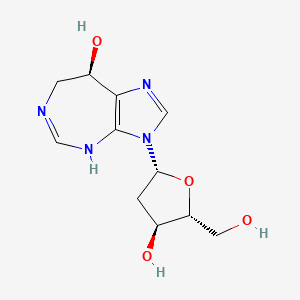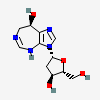Pentostatin
- pentostatin
- Deoxycoformycin
- Nipent
- 53910-25-1
- 2'-Deoxycoformycin
- Create:2005-06-24
- Modify:2025-01-18

- 2' Deoxycoformycin
- 2'-Deoxycoformycin
- CI 825
- CI-825
- CI825
- Co-vidarabine
- Deoxycoformycin
- Imidazo(4,5-d)(1,3)diazepin-8-ol, 3-(2-deoxy-beta-D-erythro-pentofuranosyl)-3,4,7,8-tetrahydro-, (R)-
- Nipent
- NSC 218321
- NSC-218321
- NSC218321
- Pentostatin
- pentostatin
- Deoxycoformycin
- Nipent
- 53910-25-1
- 2'-Deoxycoformycin
- Pentostatina
- Pentostatine
- PD-ADI
- Pentostatinum
- 2'-DCF
- CO-Vidarabine
- CI-825
- YK-176
- Vidarbine
- (R)-2'-Deoxycoformycin
- NSC-218321
- (R)-Deoxycoformycin
- PD 81565
- PD-81565
- Covidarabine
- 8R-2'-Deoxycoformycin
- Co-V
- Vira A deaminase inhibitor
- DTXSID2023436
- UNII-395575MZO7
- HSDB 6547
- 2'-Dexoycoformycin
- 395575MZO7
- Pentostatine [INN-French]
- Pentostatinum [INN-Latin]
- Pentostatina [INN-Spanish]
- BRN 1223097
- DTXCID403436
- Deaminase inhibitor (PD)
- Deaminase, inhibitor for adenosine arabinoside
- (8R)-3-(2-deoxy-beta-D-erythro-pentofuranosyl)-3,6,7,8-tetrahydroimidazo[4,5-d][1,3]diazepin-8-ol
- (8R)-3-[(2R,4S,5R)-4-hydroxy-5-(hydroxymethyl)oxolan-2-yl]-3H,6H,7H,8H-imidazo[4,5-d][1,3]diazepin-8-ol
- dCF
- NCGC00182045-01
- NSC 218321
- Pentostatine (INN-French)
- Pentostatinum (INN-Latin)
- Pentostatina (INN-Spanish)
- PENTOSTATIN (MART.)
- PENTOSTATIN [MART.]
- (R)-3-((2R,4S,5R)-4-Hydroxy-5-(hydroxymethyl)tetrahydrofuran-2-yl)-3,4,7,8-tetrahydroimidazo[4,5-d][1,3]diazepin-8-ol
- (R)-3-(2-Deoxy-.beta.-D-erythro-pentofuranosyl)-3,6,7,8-tetrahydroimidazo(4,5-d)(1,3)diazepin-8-ol
- (R)-3-(2-Deoxy-beta-D-erythro-pentofuranosyl)-3,6,7,8-tetrahydroimidazo(4,5-d)(1,3)diazepin-8-ol
- CL 67310465
- 2' Deoxycoformycin
- Imidazo(4,5-d)(1,3)diazepin-8-ol, 3-(2-deoxy-beta-D-erythro-pentofuranosyl)-3,6,7,8-tetrahydro-, (R)-
- CI-825;Deoxycoformycin
- (8R)-3-(2-Deoxy-beta-D-erythro-pentofuranosyl)-3,4,7,8-tetrahydroimidazo[4,5-d][1,3]diazepin-8-ol
- Pentostatn
- Pentostatin (JAN/USAN/INN)
- (R)-3-(2-deoxy-beta-D-erythro-pentofuranosyl)-3,6,7,8-tetrahydroimidazo[4,5-d][1,3]diazepin-8-ol
- Pentostatin [USAN:INN:BAN:JAN]
- Pentostatin (PTN)
- CI 825
- MFCD00078802
- Pentostatin (Standard)
- PENTOSTATIN [MI]
- 2'dCF
- PENTOSTATIN [INN]
- PENTOSTATIN [JAN]
- CL-67310465
- PENTOSTATIN [HSDB]
- PENTOSTATIN [USAN]
- PENTOSTATIN [VANDF]
- SCHEMBL2817
- CHEMBL1580
- PENTOSTATIN [WHO-DD]
- (8R)-3-[(2R,4S,5R)-4-hydroxy-5-(hydroxymethyl)oxolan-2-yl]-7,8-dihydro-4H-imidazo[4,5-d][1,3]diazepin-8-ol
- BIDD:GT0136
- GTPL4805
- BDBM22925
- CHEBI:27834
- HY-A0006R
- Pentostatin, >=95% (HPLC)
- L01XX08
- PENTOSTATIN [ORANGE BOOK]
- BDBM223291
- HY-A0006
- Imidazo(4,5-d)(1,3)diazepin-8-ol, 3-(2-deoxy-.beta.-D-erythro-pentofuranosyl)-3,6,7,8-tetrahydro-, (R)-
- Tox21_113417
- s9521
- AKOS024456918
- AKOS032949742
- CS-0374
- DB00552
- NCGC00388420-02
- Imidazo(4,5-d)(1,3)diazepin-8-ol, 3-(2-deoxy-beta-D-erythro-pentofuranosyl)-3,4,7,8-tetrahydro-, (R)-
- Imidazo(4,5-d)(1,3)diazepin-8-ol, 3-(2-deoxy-D-erythro-pentofuranosyl)-3,4,7,8-tetrahydro-, (8R)-
- Imidazo[4,5-d][1,3]diazepin-8-ol, 3-(2-deoxy-.beta.-D-erythro-pentofuranosyl)-3,4,7,8-tetrahydro-, (8R)-
- CAS-53910-25-1
- NS00005086
- C02267
- D00155
- EN300-222177
- Q425470
- SR-01000883935
- J-523899
- SR-01000883935-1
- BRD-K91543828-001-02-0
- Adenosine Deaminase Inhibitor, DCF - CAS 53910-25-1
- Z2204459563
- (R)-3-(2-Deoxy-beta-D-erythro-pento-furanosyl)-3,6,7,8-tetrahydroimidazo
- (8R)-3-[(2R,4S,5R)-4-hydroxy-5-(hydroxymethyl)oxolan-2-yl]-3H,4H,7H,8H-imidazo[4,5-d][1,3]diazepin-8-ol
- (8R)-3-[(2R,4S,5R)-4-hydroxy-5-(hydroxymethyl)tetrahydrofuran-2-yl]-7,8-dihydro-6H-imidazo[4,5-d][1,3]diazepin-8-ol
- (R)-3-((2R,4S,5R)-4-Hydroxy-5-(hydroxymethyl)tetrahydrofuran-2-yl)-3,6,7,8-tetrahydroimidazo[4,5-d][1,3]diazepin-8-ol
- (R,Z)-3-((2R,4S,5R)-4-hydroxy-5-(hydroxymethyl)tetrahydrofuran-2-yl)-3,6,7,8-tetrahydroimidazo[4,5-d][1,3]diazepin-8-ol
135.066498 100
136.050461 27.53
108.055649 22.26
81.044930 12.49
118.039948 9.30

P264, P270, P301+P316, P321, P330, P405, and P501
(The corresponding statement to each P-code can be found at the GHS Classification page.)
Aggregated GHS information provided per 40 reports by companies from 2 notifications to the ECHA C&L Inventory.
Information may vary between notifications depending on impurities, additives, and other factors. The percentage value in parenthesis indicates the notified classification ratio from companies that provide hazard codes. Only hazard codes with percentage values above 10% are shown.
Hazard Traits - Developmental Toxicity
Authoritative List - Prop 65
Report - regardless of intended function of ingredient in the product
In clinical trials, serum enzymes elevations occurred in up to 25% of patients receiving pentostatin, but the abnormalities were generally mild and transient and rarely required dose modification. Clinically apparent liver injury from pentostatin is rare, but striking instances of severe liver injury leading rapidly to multiorgan failure and death have been described both in adults and children. The time to onset varied from a few days to six months. The possible role of shock, ischemia, opportunistic infections and sepsis in these cases has not always been well defined. Both hepatocellular and cholestatic patterns of enzyme elevations have been described. Immunoallergic features and autoantibodies were not typical.
Likelihood score: D (possible rare cause of clinically apparent liver disease).
M Chen, V Vijay, Q Shi, Z Liu, H Fang, W Tong. FDA-Approved Drug Labeling for the Study of Drug-Induced Liver Injury, Drug Discovery Today, 16(15-16):697-703, 2011. PMID:21624500 DOI:10.1016/j.drudis.2011.05.007
M Chen, A Suzuki, S Thakkar, K Yu, C Hu, W Tong. DILIrank: the largest reference drug list ranked by the risk for developing drug-induced liver injury in humans. Drug Discov Today 2016, 21(4): 648-653. PMID:26948801 DOI:10.1016/j.drudis.2016.02.015
Patents are available for this chemical structure:
https://patentscope.wipo.int/search/en/result.jsf?inchikey=FPVKHBSQESCIEP-JQCXWYLXSA-N
- BindingDBLICENSEAll data curated by BindingDB staff are provided under the Creative Commons Attribution 3.0 License (https://creativecommons.org/licenses/by/3.0/us/).https://www.bindingdb.org/rwd/bind/info.jspPentostatin (PTN)https://www.bindingdb.org/rwd/bind/chemsearch/marvin/MolStructure.jsp?monomerid=223291(8R)-3-[(2R,4S,5R)-4-hydroxy-5-(hydroxymethyl)oxolan-2-yl]-3H,6H,7H,8H-imidazo[4,5-d][1,3]diazepin-8-olhttps://www.bindingdb.org/rwd/bind/chemsearch/marvin/MolStructure.jsp?monomerid=22925
- ChEMBLLICENSEAccess to the web interface of ChEMBL is made under the EBI's Terms of Use (http://www.ebi.ac.uk/Information/termsofuse.html). The ChEMBL data is made available on a Creative Commons Attribution-Share Alike 3.0 Unported License (http://creativecommons.org/licenses/by-sa/3.0/).http://www.ebi.ac.uk/Information/termsofuse.htmlChEMBL Protein Target Treehttps://www.ebi.ac.uk/chembl/g/#browse/targets
- Comparative Toxicogenomics Database (CTD)LICENSEIt is to be used only for research and educational purposes. Any reproduction or use for commercial purpose is prohibited without the prior express written permission of NC State University.http://ctdbase.org/about/legal.jsp
- Drug Gene Interaction database (DGIdb)LICENSEThe data used in DGIdb is all open access and where possible made available as raw data dumps in the downloads section.http://www.dgidb.org/downloadsPENTOSTATINhttps://www.dgidb.org/drugs/rxcui:8011
- DrugBankLICENSECreative Common's Attribution-NonCommercial 4.0 International License (http://creativecommons.org/licenses/by-nc/4.0/legalcode)https://www.drugbank.ca/legal/terms_of_usePentostatinhttps://www.drugbank.ca/drugs/DB00552
- IUPHAR/BPS Guide to PHARMACOLOGYLICENSEThe Guide to PHARMACOLOGY database is licensed under the Open Data Commons Open Database License (ODbL) https://opendatacommons.org/licenses/odbl/. Its contents are licensed under a Creative Commons Attribution-ShareAlike 4.0 International License (http://creativecommons.org/licenses/by-sa/4.0/)https://www.guidetopharmacology.org/about.jsp#licenseGuide to Pharmacology Target Classificationhttps://www.guidetopharmacology.org/targets.jsp
- Therapeutic Target Database (TTD)
- Toxin and Toxin Target Database (T3DB)LICENSET3DB is offered to the public as a freely available resource. Use and re-distribution of the data, in whole or in part, for commercial purposes requires explicit permission of the authors and explicit acknowledgment of the source material (T3DB) and the original publication.http://www.t3db.ca/downloadsPentostatinhttp://www.t3db.ca/toxins/T3D2822
- California Office of Environmental Health Hazard Assessment (OEHHA)
- ChEBI
- FDA Pharm ClassesLICENSEUnless otherwise noted, the contents of the FDA website (www.fda.gov), both text and graphics, are not copyrighted. They are in the public domain and may be republished, reprinted and otherwise used freely by anyone without the need to obtain permission from FDA. Credit to the U.S. Food and Drug Administration as the source is appreciated but not required.https://www.fda.gov/about-fda/about-website/website-policies#linkingFDA Pharmacological Classificationhttps://www.fda.gov/ForIndustry/DataStandards/StructuredProductLabeling/ucm162549.htm
- LiverTox
- LOTUS - the natural products occurrence databaseLICENSEThe code for LOTUS is released under the GNU General Public License v3.0.https://lotus.nprod.net/Pentostatinhttps://www.wikidata.org/wiki/Q425470LOTUS Treehttps://lotus.naturalproducts.net/
- NCI Thesaurus (NCIt)LICENSEUnless otherwise indicated, all text within NCI products is free of copyright and may be reused without our permission. Credit the National Cancer Institute as the source.https://www.cancer.gov/policies/copyright-reuseNCI Thesaurushttps://ncit.nci.nih.gov
- Open TargetsLICENSEDatasets generated by the Open Targets Platform are freely available for download.https://platform-docs.opentargets.org/licence
- California Safe Cosmetics Program (CSCP) Product Database
- New Zealand Environmental Protection Authority (EPA)LICENSEThis work is licensed under the Creative Commons Attribution-ShareAlike 4.0 International licence.https://www.epa.govt.nz/about-this-site/general-copyright-statement/Imidazo4,5-d1,3diazepin-8-ol, 3-(2-deoxy-.beta.-D-erythro-pentofuranosyl)-3,4,7,8-tetrahydro-, (8R)-https://www.epa.govt.nz/industry-areas/hazardous-substances/guidance-for-importers-and-manufacturers/hazardous-substances-databases/
- CAS Common ChemistryLICENSEThe data from CAS Common Chemistry is provided under a CC-BY-NC 4.0 license, unless otherwise stated.https://creativecommons.org/licenses/by-nc/4.0/
- ChemIDplusPentostatin [USAN:INN:BAN:JAN]https://pubchem.ncbi.nlm.nih.gov/substance/?source=chemidplus&sourceid=0053910251ChemIDplus Chemical Information Classificationhttps://pubchem.ncbi.nlm.nih.gov/source/ChemIDplus
- EPA DSSToxCompTox Chemicals Dashboard Chemical Listshttps://comptox.epa.gov/dashboard/chemical-lists/
- European Chemicals Agency (ECHA)LICENSEUse of the information, documents and data from the ECHA website is subject to the terms and conditions of this Legal Notice, and subject to other binding limitations provided for under applicable law, the information, documents and data made available on the ECHA website may be reproduced, distributed and/or used, totally or in part, for non-commercial purposes provided that ECHA is acknowledged as the source: "Source: European Chemicals Agency, http://echa.europa.eu/". Such acknowledgement must be included in each copy of the material. ECHA permits and encourages organisations and individuals to create links to the ECHA website under the following cumulative conditions: Links can only be made to webpages that provide a link to the Legal Notice page.https://echa.europa.eu/web/guest/legal-noticePentostatin (EC: 637-271-5)https://echa.europa.eu/information-on-chemicals/cl-inventory-database/-/discli/details/169812
- FDA Global Substance Registration System (GSRS)LICENSEUnless otherwise noted, the contents of the FDA website (www.fda.gov), both text and graphics, are not copyrighted. They are in the public domain and may be republished, reprinted and otherwise used freely by anyone without the need to obtain permission from FDA. Credit to the U.S. Food and Drug Administration as the source is appreciated but not required.https://www.fda.gov/about-fda/about-website/website-policies#linking
- Hazardous Substances Data Bank (HSDB)
- Human Metabolome Database (HMDB)LICENSEHMDB is offered to the public as a freely available resource. Use and re-distribution of the data, in whole or in part, for commercial purposes requires explicit permission of the authors and explicit acknowledgment of the source material (HMDB) and the original publication (see the HMDB citing page). We ask that users who download significant portions of the database cite the HMDB paper in any resulting publications.http://www.hmdb.ca/citingPentostatinhttp://www.hmdb.ca/metabolites/HMDB0014692
- ClinicalTrials.govLICENSEThe ClinicalTrials.gov data carry an international copyright outside the United States and its Territories or Possessions. Some ClinicalTrials.gov data may be subject to the copyright of third parties; you should consult these entities for any additional terms of use.https://clinicaltrials.gov/ct2/about-site/terms-conditions#Use
- DailyMed
- Drug Induced Liver Injury Rank (DILIrank) DatasetLICENSEUnless otherwise noted, the contents of the FDA website (www.fda.gov), both text and graphics, are not copyrighted. They are in the public domain and may be republished, reprinted and otherwise used freely by anyone without the need to obtain permission from FDA. Credit to the U.S. Food and Drug Administration as the source is appreciated but not required.https://www.fda.gov/about-fda/about-website/website-policies#linking
- NCI Investigational Drugs
- Drugs@FDALICENSEUnless otherwise noted, the contents of the FDA website (www.fda.gov), both text and graphics, are not copyrighted. They are in the public domain and may be republished, reprinted and otherwise used freely by anyone without the need to obtain permission from FDA. Credit to the U.S. Food and Drug Administration as the source is appreciated but not required.https://www.fda.gov/about-fda/about-website/website-policies#linking
- EU Clinical Trials Register
- FDA Orange BookLICENSEUnless otherwise noted, the contents of the FDA website (www.fda.gov), both text and graphics, are not copyrighted. They are in the public domain and may be republished, reprinted and otherwise used freely by anyone without the need to obtain permission from FDA. Credit to the U.S. Food and Drug Administration as the source is appreciated but not required.https://www.fda.gov/about-fda/about-website/website-policies#linking
- National Drug Code (NDC) DirectoryLICENSEUnless otherwise noted, the contents of the FDA website (www.fda.gov), both text and graphics, are not copyrighted. They are in the public domain and may be republished, reprinted and otherwise used freely by anyone without the need to obtain permission from FDA. Credit to the U.S. Food and Drug Administration as the source is appreciated but not required.https://www.fda.gov/about-fda/about-website/website-policies#linking
- Japan Chemical Substance Dictionary (Nikkaji)
- KEGGLICENSEAcademic users may freely use the KEGG website. Non-academic use of KEGG generally requires a commercial licensehttps://www.kegg.jp/kegg/legal.htmlUSP drug classificationhttp://www.genome.jp/kegg-bin/get_htext?br08302.kegAnatomical Therapeutic Chemical (ATC) classificationhttp://www.genome.jp/kegg-bin/get_htext?br08303.kegTarget-based classification of drugshttp://www.genome.jp/kegg-bin/get_htext?br08310.keg
- Natural Product Activity and Species Source (NPASS)
- MassBank of North America (MoNA)LICENSEThe content of the MoNA database is licensed under CC BY 4.0.https://mona.fiehnlab.ucdavis.edu/documentation/license
- Metabolomics Workbench
- NLM RxNorm TerminologyLICENSEThe RxNorm Terminology is created by the National Library of Medicine (NLM) and is in the public domain and may be republished, reprinted and otherwise used freely by anyone without the need to obtain permission from NLM. Credit to the U.S. National Library of Medicine as the source is appreciated but not required. The full RxNorm dataset requires a free license.https://www.nlm.nih.gov/research/umls/rxnorm/docs/termsofservice.htmlpentostatinhttps://rxnav.nlm.nih.gov/id/rxnorm/8011
- NORMAN Suspect List ExchangeLICENSEData: CC-BY 4.0; Code (hosted by ECI, LCSB): Artistic-2.0https://creativecommons.org/licenses/by/4.0/PentostatinNORMAN Suspect List Exchange Classificationhttps://www.norman-network.com/nds/SLE/
- PharmGKBLICENSEPharmGKB data are subject to the Creative Commons Attribution-ShareALike 4.0 license (https://creativecommons.org/licenses/by-sa/4.0/).https://www.pharmgkb.org/page/policiespentostatinhttps://www.pharmgkb.org/chemical/PA450863
- PharosLICENSEData accessed from Pharos and TCRD is publicly available from the primary sources listed above. Please respect their individual licenses regarding proper use and redistribution.https://pharos.nih.gov/aboutpentostatinhttps://pharos.nih.gov/ligands/9YTMPRAKUUAL
- Protein Data Bank in Europe (PDBe)
- RCSB Protein Data Bank (RCSB PDB)LICENSEData files contained in the PDB archive (ftp://ftp.wwpdb.org) are free of all copyright restrictions and made fully and freely available for both non-commercial and commercial use. Users of the data should attribute the original authors of that structural data.https://www.rcsb.org/pages/policies
- Springer Nature
- Thieme ChemistryLICENSEThe Thieme Chemistry contribution within PubChem is provided under a CC-BY-NC-ND 4.0 license, unless otherwise stated.https://creativecommons.org/licenses/by-nc-nd/4.0/
- WHO Anatomical Therapeutic Chemical (ATC) ClassificationLICENSEUse of all or parts of the material requires reference to the WHO Collaborating Centre for Drug Statistics Methodology. Copying and distribution for commercial purposes is not allowed. Changing or manipulating the material is not allowed.https://www.whocc.no/copyright_disclaimer/
- Wikidatapentostatinhttps://www.wikidata.org/wiki/Q425470
- WikipediaSodium trimetaphosphatehttps://en.wikipedia.org/wiki/Sodium_trimetaphosphatePentostatinhttps://en.wikipedia.org/wiki/Pentostatin
- Medical Subject Headings (MeSH)LICENSEWorks produced by the U.S. government are not subject to copyright protection in the United States. Any such works found on National Library of Medicine (NLM) Web sites may be freely used or reproduced without permission in the U.S.https://www.nlm.nih.gov/copyright.htmlPentostatinhttps://www.ncbi.nlm.nih.gov/mesh/68015649Adenosine Deaminase Inhibitorshttps://www.ncbi.nlm.nih.gov/mesh/68058892Antineoplastic Agentshttps://www.ncbi.nlm.nih.gov/mesh/68000970
- PubChem
- GHS Classification (UNECE)GHS Classification Treehttp://www.unece.org/trans/danger/publi/ghs/ghs_welcome_e.html
- The Natural Products AtlasLICENSEThe Natural Products Atlas is licensed under a Creative Commons Attribution 4.0 International License.https://www.npatlas.org/termsThe Natural Products Atlas Classificationhttps://www.npatlas.org/
- MolGenieMolGenie Organic Chemistry Ontologyhttps://github.com/MolGenie/ontology/
- PATENTSCOPE (WIPO)SID 403391315https://pubchem.ncbi.nlm.nih.gov/substance/403391315
- NCBI


